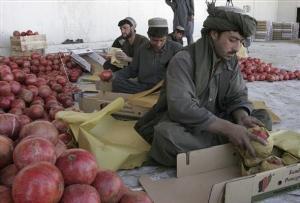Pomegranate: a fruitful way for farmers to beat deadly opium trade
Afghanistan
Thursday 27 November 2008
Farmers make about $2,000 per acre with pomegranates, versus $1,320 per acre growing poppies.
This ancient land is telling the world that it has found a replacement for the world's largest opium poppy crop. Sweet, juicy pomegranates are the latest step in a US $12 million , US-funded initiative to get Afghan farmers to turn their backs on the drugs trade.
It is hoped the pomegranate industry can cash in on the wave of the fruit's popularity in Europe and the United States, where it is celebrated for its high levels of antioxidants, which protect cells from damage by free radicals.
Afghanistan exported its first pomegranates to outlets of the French chain Carrefour in Dubai.
The fruit, larger and redder than many pomegranates imported from Turkey or North Africa, was a hit. Carrefour quickly placed orders for all its shops in the Middle East, according to US funders and Afghan officials.
Afghanistan's most successful export – agricultural or otherwise – is opium. It produced 8,200 tons of the drug in 2007, up 34 per cent on 2006. Though opium production is expected to drop back this year, Afghanistan will remain the world's largest producer of the crop by far.
On average, farmers make about $2,000 per acre with pomegranates, versus $1,320 per acre growing poppies. But in a country where large regions are still war zones, there are barriers and high costs to creating a sustainable export business.
Among Afghanistan's 48 different types of the fruit, the Kandahari pomegranate, named after the southern Afghan province where it is grown, is one of the most sought-after in India.
Afghanistan's pomegranate industry has long depended on domestic sales and small-scale exports to nearby countries, but for years, border fighting has all but ruined its reputation. Strict US pest control regulations mean that Afghan pomegranates will not be showing up in New York or California for a while yet, although American growers insist there is room in the market for everyone.





